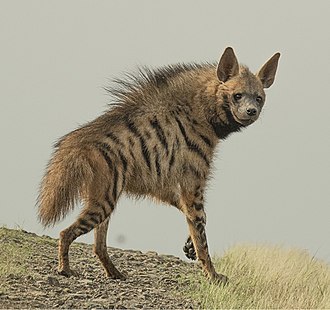Abstract
The striped hyena (Hyaena hyaena Linnaeus, 1758) is one of the large carnivores of forest and grassland ecosystems across Africa and Asia and is currently threatened throughout its range. Hyena habitats are shrinking, due to the increase of human-dominated landscapes. Increasing human-wildlife conflict, tourism, and human population growth near interface zones across the revenue lands have negative effects on the carnivores.
Introduction
The striped-hyena is a middle-sized predator with pointed ears, pale brown and males are slightly larger than the female (Pocock, 1941). Primarily, striped -hyena is a nocturnal scavenger feeding on ungulate carcasses, bones, ligaments, and cartilages but can switch between scavenging and predating as per need so they are termed as ‘opportunistic predator’ (Heptner & Sludskii 1992; Yirga et al., 2014). They have a life span of 10-12 years in the wild with no apparent seasonal pattern of reproduction, their gestation period is 90–91 days usually springing 1-6 cubs born per litter (Wagner, 2006). Striped hyena’s pack is led by a matriarch, although she participates very little in the actual hunting and females are found to have maintained smaller territory which can be easily defendable while males occupy larger territory (Jarman, 1974; Sandell, 1989).
Importance of Striped Hyena
One of the most important large scavenger with the ecosystem service role of removing carcasses and clearing off carrion in tropical ecosystem (Bhandari et al 2020). Among the four hyaenid species, only the striped hyena (hereafter hyena) is recorded in Asia (AbiSaid and Dloniak, 2015). Its distribution extends from the tropical and sub-tropical regions of East and Northeast Africa, through the Middle East and the Caucasus region, to Central Asia and into the Indian subcontinent (Wagner, 2006).
Conservation Status of the Striped Hyena
It is listed by the IUCN as Near-Threatened and placed under CITES Appendix III. The total estimated population of striped hyenas all over the world is less than 10,000 individuals (Abi-Said 2007). The main factors which result in the decline of striped-hyena include retaliatory killings, habitat loss, low food availability, resource competition etc. Habitat loss is also a major concern as India’s grasslands are dying.

Potential Hyena Habitat
Devi river is one of the principal distributaries of Mahanadi in Odisha and its estuarine belt was once a major mass-nesting grounds for the massive Olive ridley sea turtles. This was a potential site for Hyena sps. which fed on the eggs deposited by the sea turtles in the beaches. Due to the raised pressure upon the habitat for fulfilling human necessities, as there is continuous habitat fragmentation, degradation of existing patches and high level of casuarina plantations in this area, there is a tremendous pressure on Hyena population.
The effect of climate change in association with the degrading habitat due to high fishing activities and other disturbances like firewood collection etc. has led to the lack of utilization of this coastal belt by Olive ridley sea turtles for their mass-nesting purpose. The shifting of the nesting behavior of the sea turtles has impacted on the loss of food available to the existing Hyena populations in this area. There has been an increased inter-specific competition between the Hyena and the Golden Jackal sps. Canis aureus Which occurs predominantly in this landscape.
Study area
Astaranga 19°58′46″N 86°16′10″E is a small fishing and agricultural village (133.05 sq.km) located in the eastern coast of Bay of Bengal in Puri district of Odisha 19°58′N and 86°16′E. Astaranga is a combination of two words, ‘Asta’ and ‘Ranga’ which means ‘Colourful Sunset’ in odiya. It is a great tourist spot and a revenue land. The climate is moist and hot, with the average annual rainfall between 1000 and 1200 mm and average temperature of 27 °C, and with little variation throughout the year. 67,748 inhabitants live primarily along the narrow coastal plain. This is a highly disturbed habitat due to presence of heavy deposition of mineral ores like ilmenite, garnet, Silimanite, rutile, Zircon etc. (Mohapatra et al. 2015).
Puri is famous for the Jagannath temple which is claimed to have a Swarg Dwar (An entrance to heaven after death). In this region under the Harishchandra yojna the trees are planted and every 10 years are cutted. This plantation occurs each year and successive deforestation is done at regular intervals for old mature trees. The wood of old trees are used to burn the dead bodies of people.
Methodology and Observations
There are several direct and indirect drivers of population decline of Hyena in this area. In order to combat this our team initiated a Rapid Assessment project to assess the present population status of Hyena and monitor the condition of the surviving population and the rate of disturbance occurring in this habitat. Regular monitoring and field surveys with conducting focal group interviews with local communities was done. In our camera trap record a Jackal was found running behind the Hyena cub.
Future Perspective for Striped Hyena Conservation
The study is being continued at the present to monitor and assess the various threats associated with the existing Hyaena population which is directly or indirectly affecting its distribution and ecological requirements in this area. We think that awareness is the key to major conservation issues related to the aspect where both wildlife and humans comes into interface. As per the observations the suitable mitigation strategies will be further provided to minimize the pressure upon the existing population of Hyaena in this area. Being important scavengers, their conservation is neccessary. The loss of another scavenger, the vulture, proved devestating for human and ecosystem health.
References
AbiSaid, M., & Dloniak, S. M. D. (2015). Hyaena hyaena. The IUCN red list of threatened species 2015: e. T10274A45195080.
Bhandari, S., Morley, C., Aryal, A., & Shrestha, U. B. (2020). The diet of the striped hyena in Nepal’s lowland regions. Ecology and Evolution, 10(15), 7953-7962.
Wagner, A. P. (2006). Behavioral ecology of the striped hyena (Hyaena hyaena). Montana State University.
1*Earth Crusaders Organisation (ECO), Bhubaneswar, Odisha–751019, India shreyapandey.2244@gmail.com
1PGDESD, Indira Gandhi National Open University, Bhubaneswar – 751014, Odisha.
